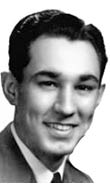Peña remembered as visionary architect, war hero, benefactor

Willie Peña, WWII
William Merriweather Peña ‘42, one of the Texas A&M College of Architecture’s most revered former students whose legendary architectural career followed a heroic tour of duty in World War II, died in Houston Feb. 10, 2018. It was his 99 th birthday.
Funeral services took place Feb. 15 at St. Michael Catholic Church in Houston.
“Peña was an architectural visionary, advocate and champion, a World War II hero and a generous philanthropist whose indelible contributions to his profession and the world will not be forgotten,” said Jorge Vanegas, dean of the College of Architecture.
In 2016, with a substantial gift Peña established a Department of Architecture endowment that will provide generations of aspiring Aggie architects with transformational learning, research and service opportunities.
"Scholarship holders will not only receive support for their academic studies through the program, but they will be custodians of the legacy and selfless service of a great man," said Vanegas.
Peña began his architectural career at [Caudill, Rowlett and Scott] (http://crs.arch.tamu.edu/about-us/history/) in 1948 and was promoted to firm partner in 1949. At CRS, Peña was a pioneer in architectural programming, a vital part of the design process that provides the general direction a building’s design should take after a client’s goals and needs are determined.
He developed a process in which a designer and client to determine numerous critical issues that affect architectural design, such as the specific use of a structure’s space, the amount of its occupants and the type of their activities, the project’s budget, and other crucial considerations.
Peña, who programmed more than 400 projects at CRS, and two colleagues, William Caudill and John Focke, detailed the process in the 1969 book “Problem Seeking.” Now in its fifth edition, “Problem Seeking” is a standard textbook in architectural education.
In 1970-73, Peña, as a consultant to the National Council of Architectural Registration Boards, authored the architectural programming section of the council’s examination that serves as a key step on the path to licensure in the U.S.
Peña’s professional career began after nearly losing his life while serving in the European theater in World War II.
Commissioned as an army second lieutenant May 17, 1942 — the day after he graduated from Texas A&M — Peña began officer training, and then was deployed to Europe in September 1944. Peña was part of Allied forces who engaged the German army in the Battle of the Bulge, which lasted from December 1944 – January 1945.
In March 1945, Peña was with fellow soldiers near Schlieden, Germany when he stepped on a land mine while repairing a unit communications line.
“… I must have stepped off the hard-top (road) onto the muddy shoulder,” said Peña in his 1991 World War II memoir, “ [As Far As Schlieden] (http://crs.arch.tamu.edu/activites/publications/AS%20FAR%20AS%20SCHLEIDEN.pdf) ” (59MB PDF).
“An ear-splitting explosion below numbed me as I felt myself rising, head bowed, in the air,” he said. He eventually lost a leg in the explosion and was sent to the United States to recover.
Pena earned numerous awards and honors for his architectural achievements and wartime service.
In 1972, Peña was elevated to membership in the American Institute of Architects’ [College of Fellows] (https://network.aia.org/cof/home) , one of the highest honors conferred on an American designer.
In 1998, he was an inaugural recipient of the Texas A&M College of Architecture’s [Outstanding Alumni] (http://www.arch.tamu.edu/community/formerstudents/outstanding-alumni/) award, which is presented to former students who have established themselves as leaders and humanitarians in their respective fields.
In 2000, he was the first architect to receive the Thomas Jefferson Award given annually by the AIA Houston Chapter. In 2009, in Peña’s name, the AIA Houston Chapter presented a chair designed by architect Finn Juhl to the AIA Houston Design Collection at the Museum of Fine Arts Houston.
In 2015, he received Texas A&M’s Distinguished Alumnus Award, the highest honor the university bestows on its former students.
Peña also earned honors from France and Belgium, nations that he helped liberate in WWII.
He was part of a group of fellow soldiers who received France’s highest honor, the medal of Chevalier of the [National Order of the Legion of Honour] (http://www.britannica.com/EBchecked/topic/335043/Legion-of-Honour/) , during a 2013 Veterans Day [ceremony] (http://www.csnhouston.com/blog/astros-talk/astros-host-special-event-minute-maid-park-veterans-day) at Minute Maid Park in Houston.
In 2017, Peña received Belgium’s second-highest order of Chivalry, the Commander in the Order of the Crown, from Belgian Princess Astrid in a Rudder Theatre ceremony on the Texas A&M campus.
His other military awards include the Bronze Star, the Purple Heart and the French Certificate Croix de Guerre.
Astrid was part of a Belgian delegation that attended the formal opening of “ [Texas Aggies Go To War] (http://aggiesgotowar.org/) ,” a multimedia exhibit at the Memorial Student Center that honored Peña and four fellow Aggie WWII heroes who exemplify the dedication and sacrifice representative of all Aggies who served.
Born Feb. 10, 1919, in Laredo, Texas, Peña was preceded in death by his brothers, Gustavo and Augusto Pena and his father Eduardo, a grocer, and mother, Celentina, a homemaker.
Richard Nira
rnira@arch.tamu.edu
Tags
Related Posts
Aggie-founded arch program flourishing in Bangladesh
Outstanding alum chosen to receive honorary Ph.D.
McKittrick funeral services take place at Rice University

Alumnus hosts Oct. 12 Nat Geo TV show
Follow Us
Facebook Twitter Vimeo Youtube Flickr RSS
Recent Posts

Planning prof heads study of disaster housing aid

A message from the dean

Former student remembered as expert planner

Leading educator named new head of Architecture Dept.











_thumbnail_small.png)
